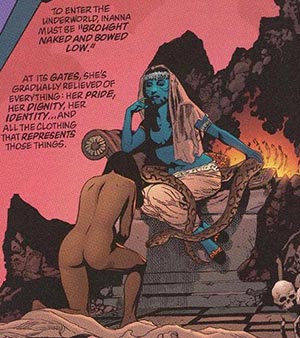 |
|||||||||||||
|
The Underworld: Ereshkigal Review "The Underworld: Ereshkigal"  This graphic, illustrating Inanna bowing before Ereshkigal, is from the Promethea 32 issue comic series by Alan Moore and J. H. Williams (1999 - 2005), now available in book form.
This graphic, illustrating Inanna bowing before Ereshkigal, is from the Promethea 32 issue comic series by Alan Moore and J. H. Williams (1999 - 2005), now available in book form. Britannica has this to say about her: Ereshkigal. Mesopotamian goddess. Ereshkigal, in Mesopotamian religion, goddess in the Sumero-Akkadian pantheon who was Lady of the Great Place (i.e., the abode of the dead) and in texts of the 3rd millennium BC wife of the god Ninazu (elsewhere accounted her son); in later texts she was the wife of Nergal. Ereshkigal’s sister was Inanna (Akkadian: Ishtar), and between the two there was great enmity. In the rendezvous of the dead, Ereshkigal reigned in her palace, on the watch for lawbreakers and on guard over the fount of life lest any of her subjects take of it and so escape her rule. Her offspring and servant was Namtar, the evil demon, Death. Her power extended to earth where, in magical ceremony, she liberated the sick possessed of evil spirits. Ereshkigal’s cult extended to Asia Minor, Egypt, and southern Arabia. In Mesopotamia the chief temple known to be dedicated to her was at Cuthah. |
| Copyright © Redefining the Sacred. All rights reserved. | |